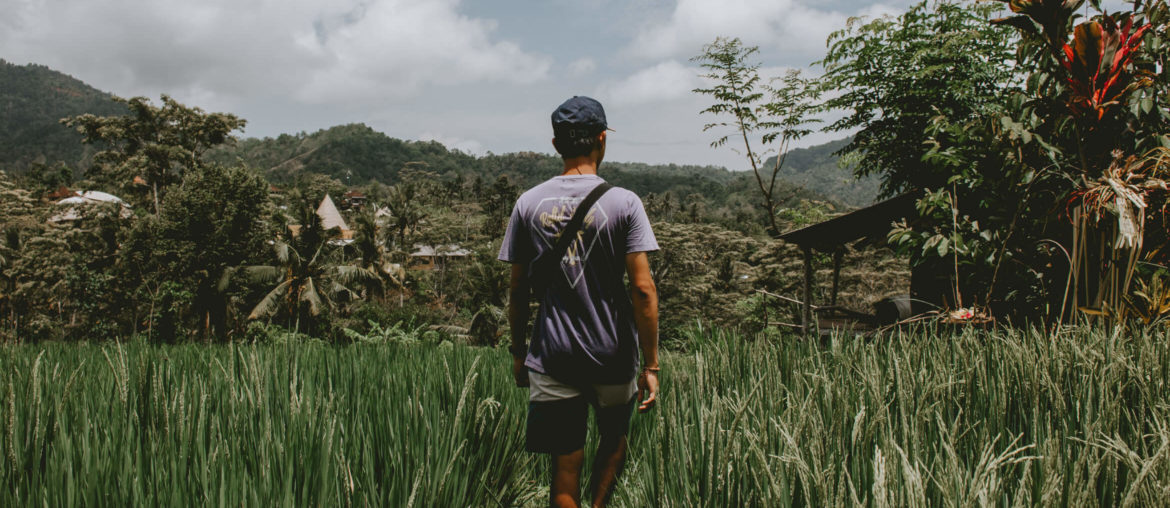Currently ten months into my third extended-stay on the island of Bali, I’ve been very fortunate that travel restrictions have allowed me to stay here longer than expected.
There are not many places in the world that are as welcoming, beautiful, and comfortable as Bali and the lifestyle agrees with me in various respects. This has not been overlooked by the digital nomad community and there is a thriving scene of coworking spaces, networking events, and activities. Visitors to Bali are likely to notice the distinct Bali culture and the ways that traditions are practiced every day.
The Uniqueness of Balinese Culture
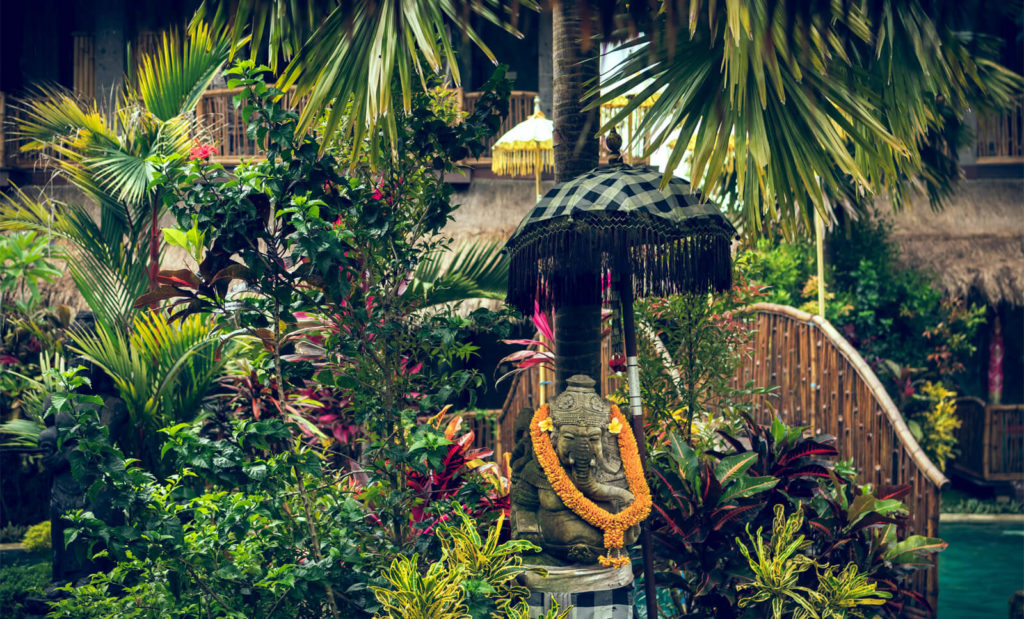
The Indonesian island known as ‘Island of the Gods’ mostly differs from the rest of the island nation in that the majority religion is not Islam. Hinduism arrived in Indonesia in the first century A.D., either through the influence of Indian traders, or the admiration that Indonesian royalty developed for Indian culture and religions. In the 13th century, Islamic visitors caused a gradual conversion to Islam in most of the country.
Conflicts between Islam and Hinduism in the country were prevented by the European colonial powers, who encouraged the preservation of Hindu beliefs and traditions in Bali and Western Java. In particular, the Dutch colonial rule in Indonesia allowed local cultures and traditions to flourish rather than enforcing European beliefs and practices. As a result, the Balinese faith and practices are notably singular. While they are uninfluenced by Islam, they also stand at a distance from the Hindu practices of India. Bali Hinduism also incorporates ancestor worship, local animism, and the reverence of Buddist figures.
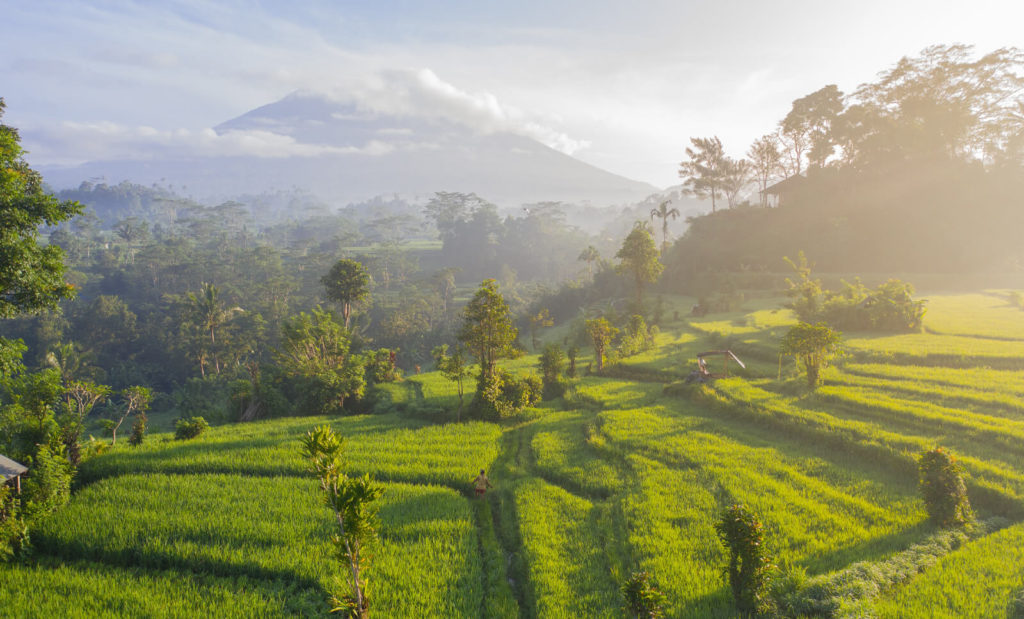
Religion and rituals are an important part of everyday life throughout Bali and for those who have traveled throughout Asia, Bali stands alone for an unrecognizable culture that complements incredible natural beauty. Traveling through the island will take you from white sand beaches in the south, across rice fields, and through dense jungle valleys, to high volcanoes and lakes in the north. Drivers need to show patience for ceremonies that fill up the street and take place quite frequently and be careful not to run into monkeys that can be found in many places.
The island is volcanic and it has active volcanoes, as I found on my stay in late 2017 when panic was caused by the rumblings of Mount Agung. The doomsday eruption that some people were fearing did not materialize and my trip went on uninterrupted. The volcanic nature of the island can be noticed on visits to the active and dormant volcanoes in the north, the black sands of the east coast, and the richly vegetated jungles of the central regions.
The Aesthetic Beauty of Bali
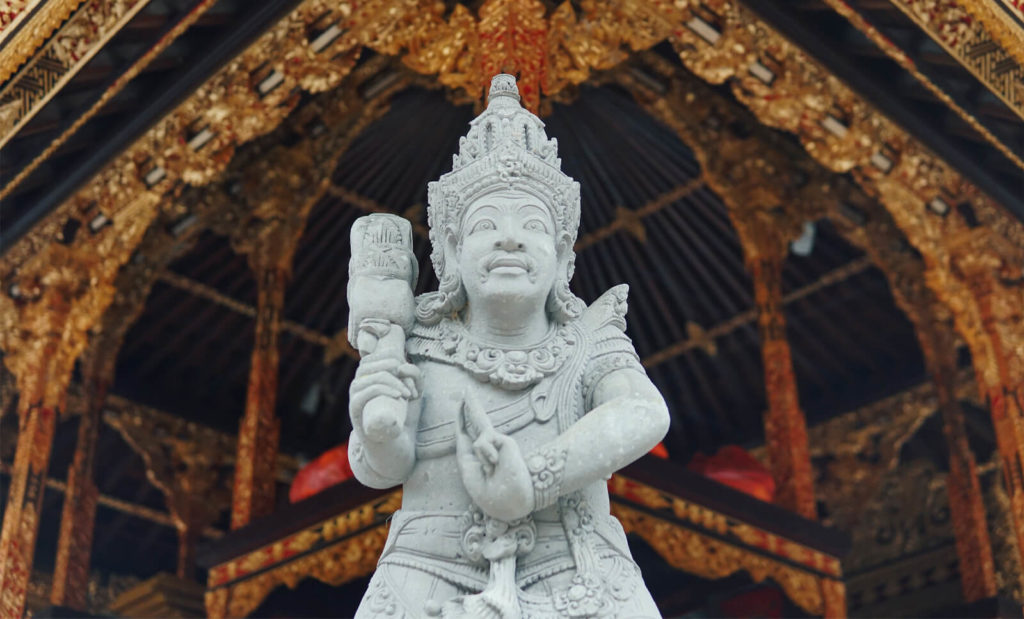
Bali is especially well known for its visual beauty and its traditions and practices that enhance that beauty. The island is an important center for art, which extends back many centuries and has Hindu and Javanese origins. This includes paintings, woodcarvings, stone carvings, and gold and silver artwork. Bali continues to have a vibrant art scene, drawing artists and buyers from home and abroad. It is not at all surprising that somewhere as colorful and diverse as Bali would inspire many artists, as well as a rich and vibrant culture.
Like the Japanese but in a tropical environment, the Balinese are masters of design. The architecture is rooted in centuries of tradition and the interior design is both attractive and functional. This can be noticed in high roofing, wooden framing, and cool, natural ventilation. The traditions of design emphasize the importance of the harmony the occupants of a house will have with nature and the gods. There is also a strict set of rules for the way space is allocated, as well as certain places for shrines and symbols.
Bali also has a very particular style of furniture that is often elaborately carved and made from teak or mahogany. This design of wooden furniture is both comfortable and ornate, as most visitors to Bali will easily notice. Balinese furniture is also a major export to locations around the world.
There are various ways in which the Balinese show a tendency to beautify the environment around them. This may be through the use of carvings, patterned clothing, flowers, incense, and gifts. All of this makes the island a happy, comfortable, and welcoming environment for everyone.
Customs and Practices in Bali
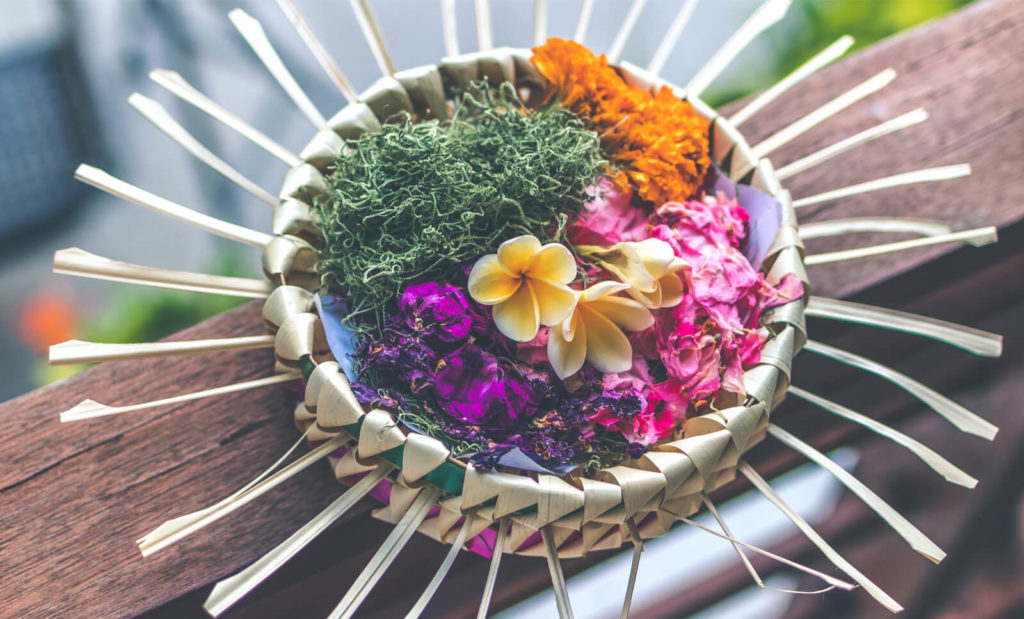
One of the most noticeable rituals of Bali culture is the preparing and presenting of Canang Sari, which are daily offerings made to the god of Balinese Hinduism, Sang Hyang Widhi Wasa. These consist of small palm-leaf baskets that hold a collection of plants and flowers, each with a different symbolic significance, as well as an offering of rice, biscuits, or even cigarettes, with burning incense as a final touch. These represent the sacrifice of time and wealth and they are placed in front of households and businesses, on vehicles, and at places of worship. A great deal of time and effort is put into the production and distribution of this ritual and it is carried out with patience and happiness.
Another sight to be noticed at certain times of year are the penjor, which are meticulously decorated bamboo poles that are erected at every threshold. At the time of Galungan, the streets are full of bright and beautiful penjor, the end of which curves and hangs a symbolic gift for the gods and ancestors.
In Bali, you should not point using your finger and use your hand in a downward position if you need to make a gesture. The right hand should also be used to give and receive presents as the left hand is seen as being unclean. It is customary to remove your shoes before entering a building and not use your feet to point, as all parts of the body lower than the navel are considered to be impure. All visitors to temples are required to cover up from the waist down and sarongs are often provided for this purpose.
In the past, Balinese women commonly exposed their breasts in public, as is portrayed in traditional Balinese art, but this changed more recently to meet international conventions. Visitors should avoid being too affectionate with their partners in public by kissing or touching each other. It is also better to dress modestly at all times in public.
Balinese people are incredibly friendly, kind, and generous. They are very gentle and they leave the impression that they always consider others before themselves. They will do anything they can to avoid conflict, so it is always best to be sensitive to how you may be offending. People from western cultures are usually more direct in their interactions, so visitors should make allowances for any miscommunications.
Communication in Bali
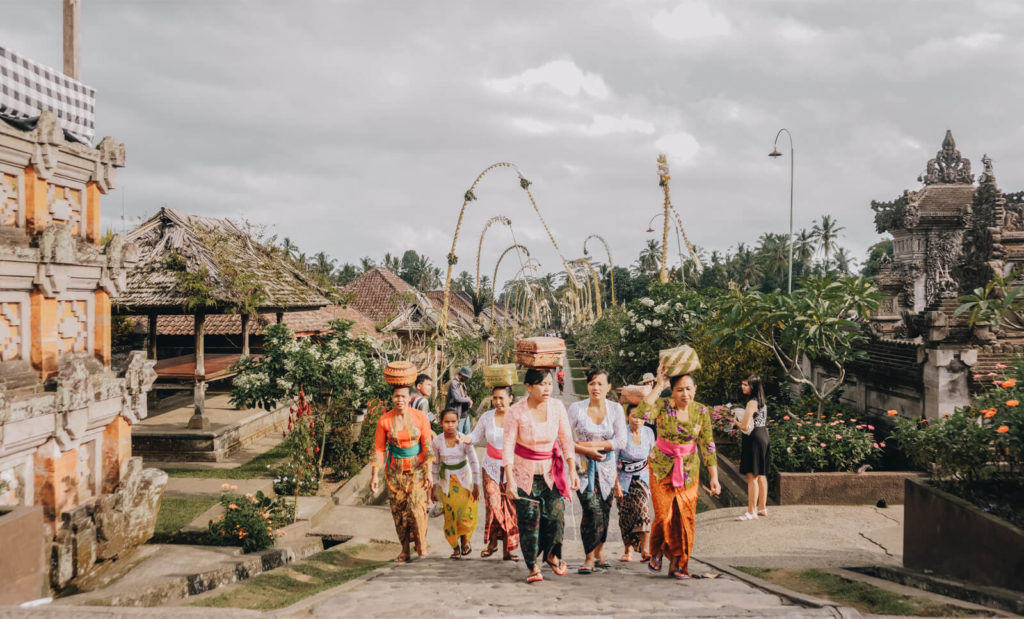
Similar to Thai and Indian cultures, the most common Balinese salutation is made by joining your hands together at the chest in a prayer position. This can be paired with a greeting of ‘Om Swastiastu’, which means ‘May peace, happiness, and prosperity be with you’.
It is extremely common for Balinese people to smile at each other, even when this may be strangers that they pass in the street. This does not mean that there is an ulterior motive, as people from other parts of the world may be led to believe. The Balinese are simply happy and trusting of other people.
For those that spend some time in Bali, it is a good idea to learn some basic phrases that local people will appreciate. Bahasa Indonesia is the language that is used as a lingua franca and it can be understood throughout the country, while Balinese is more familiar to the people of Bali. For example, the words for ‘Thank you’ are ‘Terima Kasih’ in Indonesian and ‘Suksma’ in Balinese. Both of these terms are commonly used in Bali. Similarly, the words for ‘You’re welcome’ is ‘Sama Sama’ in Indonesian and ‘Mewali’ in Balinese.
Festivals in Bali
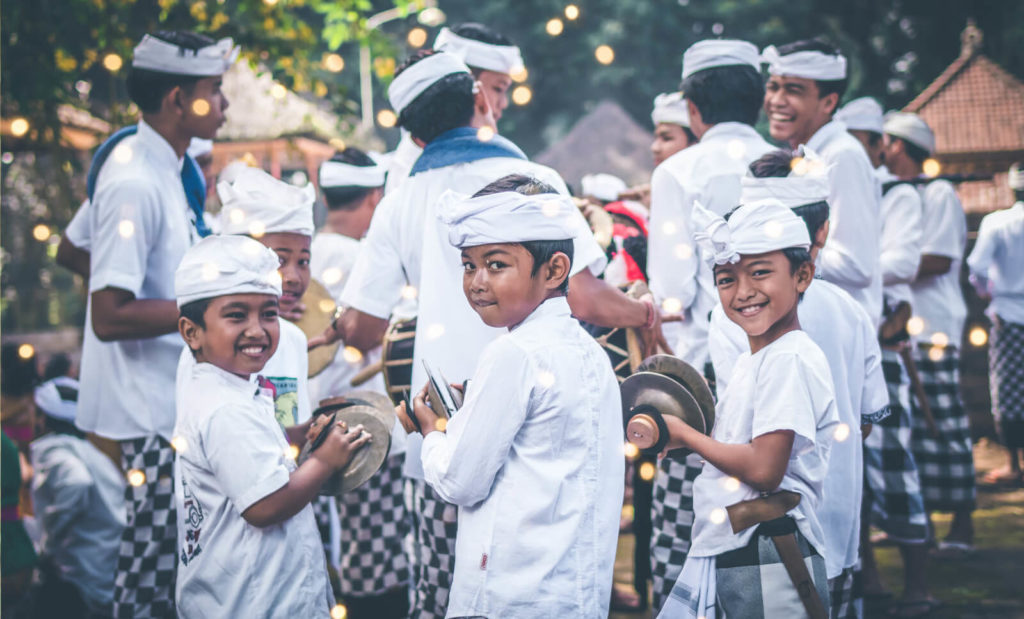
In Bali, it often seems that traditional Balinese festivals are continually taking place, as there are so many events and festivities, added to by local celebrations. At these times, Balinese people wear traditional dress and sometimes take part in gamelan, the traditional Balinese music, and traditional dancing.
Nyepi is the day of silence that is observed just before the new year of the Balinese Suka (lunar) calendar, which is usually in March. This is a public holiday of self-reflection on which Balinese people meditate and fast. The restrictions force people to stay at home and be quiet, internet coverage is stopped, and Bali’s Ngurah Rai airport is closed for the day. This prohibition is for all people in Bali, not just the Balinese and it is enforced by local security forces. The day after Nyepi is New Year’s Day when families and friends meet and ask for forgiveness from each other.
The Balinese Pakuwon calendar is Hindu in origin and is just 210 days in length. The most important event of this calendar is Galungan, a day that symbolizes the victory of dharma over adharma. On this day, ancestral spirits return to their former homes to visit their living relatives. On the day of Kuningan, 10 days after Galungan, the spirits return to the afterlife, then Manis Kuningan, the next day, is for celebration.
Other notable events include Odalan, which is specific to every temple in Bali, Saraswati, for the goddess of knowledge, and Pagerwesi for the strengthening of the soul. Balinese festivals often involve visiting temples or holy sites, purification in natural water, sacrifice and the giving of gifts, and celebration through music, dance, puppetry, and food.
Bali is a fascinating, breathtakingly beautiful, and inviting island in the tropics that draws the attention of many travelers and digital nomads. While it is always possible to live a comfortable life here at a remove from the local Bali culture and traditions, becoming closer to the Balinese way of life is decidedly the best way to appreciate this complex and divine place. Life in Bali is certainly agreeable for everyone, but delving deeper will reveal the true soul of the island.
Where to next? Find flexible month-to-month rentals across the globe on Anyplace.

